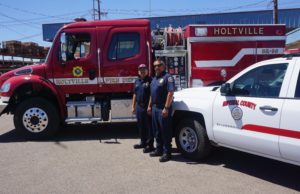
Holtville Fire Chief Alex Silva (left) and Imperial County Fire Battalion Chief Angel Morales are pictured next to a Holtville Fire brush truck and county fire vehicle. The brush truck was used to help fight the Mendocino Complex Wildfire. Brush trucks have become a critical tool to reaching rugged terrain in the battle to stop raging brush fires.
When two Northern California wildfires joined to become a massive inferno known as the Mendocino Complex Fire, the largest wildfire in California’s history, thousands of firefighters from throughout the state joined in the fight to stop the blaze and protect human life and property.
Firefighters from the Imperial Valley were among them.
For more than a month, Valley firefighters have joined crews from throughout California—and even international crews—to slow a wildfire that has scorched more than 450,000 acres and still has not been fully extinguished (at the time this story is being written)—but is no longer the nearly unstoppable, rampaging monster it once was.
While the Mendocino Complex Fire may be the largest blaze, it is by far not the only California wildfire local fire crews have responded to this fire season. So far they have been dispatched to seven fires outside of the county—and the fire season isn’t over. More calls for mutual aid in the state could—and mostly likely will—come.
Responding to wildfires is just one dangerous part of what is already a career where your job regularly involves placing yourself in danger’s way, but Imperial Valley firefighters are prepared to help when called upon.
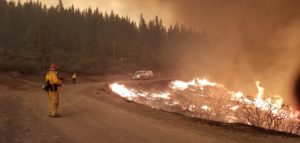
Imperial Valley fire crews attack flames at the Mendocino Complex Fire. Photo from Imperial County and Holtville Fire Departments.
Not long after their return from the Mendocino Complex Fire, three local fire responders met at the Holtville Fire Department headquarters to share stories of their experience and what it takes to respond to wildfires around the state.
“Here in the Valley we have great fire crews that are ready and able to go to fires anywhere in California and locally,” said Holtville Fire Chief Alex Silva, who also serves as the mutual aid strike team coordinator for the Valley. When a mutual aid call comes from the state, it is Silva who must quickly get crews ready to respond. “We have great leaders who can get these guys to a fire and get them back safe.”
Silva was part of the first of two strike teams from the Valley that responded to Mendocino. In all, some 44 Imperial Valley firefighters responded over the course of a month. His strike team had already been called to another fire, the Cranston Fire in Riverside County, where they worked for five days before being transferred to the Mendocino blaze.
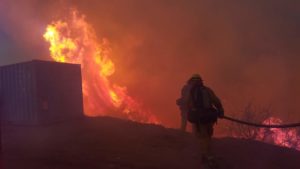
Local crews join in battling the Mendocino blaze. Photo from Imperial County and Holtville Fire Departments.
He called the Cranston and Mendocino fires “the California fire tours part two”. Just weeks earlier, strike teams had responded to what he called “the California fire tours part one”—starting with the Pawnee Fire in Lake County, then to a blaze in Redding, next to Woodland, and finally ended up in San Bernardino. For good measure, local crews also responded to a wildfire that scorched portions of Alpine.
Soon after, came the Cranston and Mendocino fires.
Silva said of Mendocino: “When we got there, it had burned about 20,000 acres. Every day that we went to briefing, we realized this thing was getting bigger and bigger.”
Imperial County Fire Department Battalion Chief Angel Morales was also a leader of the first strike team to the massive blaze. “It was a bit of a challenge,” Morales said. “We knew we were going to be part of the initial attack, so that meant no sleep, no showers, and no food.”
The Mendocino fire grew so large that a second Imperial Valley strike team was sent in to relieve the first team after it had served two weeks on the fire line. Holtville Firefighter Brad Kaufman was part of that second wave of local firefighters. He said of facing such a massive fire: “There are definitely times when you think about the danger of what you are doing, but you try not to be too fearful of it, and you just try to watch out for each other.”
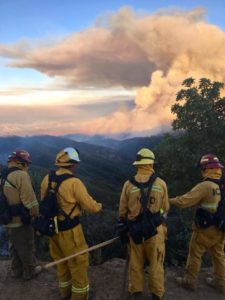
Local firefighters take in the extent of the wildfire. Photo from Imperial County and Holtville Fire Departments.
Responding to a wildfire out of county is never easy, but under California’s mutual aid system, firefighters expect it. Silva said it is important to be ready to support fire crews from throughout the state when the need comes. Likewise, when Imperial Valley has needed support, crews from outside the county have responded to the call for help. “Number one, we feel a sense of responsibility to respond because this is our state,” Silva said. “And when we’ve needed help down here, they have come to us.”
An example took place in April at a major fire in the Rio Bend area of the Valley. In that case, San Diego County fire crews responded to the mutual aid call.
When Imperial Valley gets the call for help, they mobilize in a matter of an hour or two and then begin the journey to the blaze. In the case of the Mendocino Complex Fire, it was a 14-hour drive. Then, once they arrive, the assignments come, and every assignment is for a 24-hour shift. That means crews can be up for 36 to 48 hours from the time they get the call, arrive on scene, and find themselves assigned to battle the fire.
While it may not be easy, they say they don’t mind it because they know they have a purpose: to protect human life and people’s property.
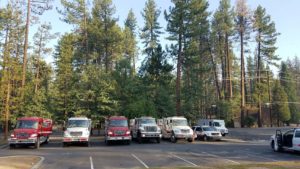
Pictured are the fleet of Imperial Valley fire vehicles used to fight the Mendocino blaze. Photo from Imperial County and Holtville Fire Departments.
While on assignment, safety is key and lives depend on following a very strict set of guidelines established under what firefighters call the incident command system (ICS). “The incident command system is how we prep for the magnitude of the fire—by highly implementing the command system,” Morales said.
Under the ICS, a chain of command is established as well as a line of communication, so everyone’s role is well defined. Once in the field—in the Mendocino case—dispatched often high up in the mountains in danger’s way to stop the fire’s advance—following orders under the ICS is the way to maintain order in what can quickly become a chaotic situation.
“Our common goal is to put out the fire,” Morales said.
Even with all the safety and command procedures followed, fighting a massive wildlife for 14 days with little rest can be exhausting and stressful. Downtime for fire crews brings little comfort as they sleep in tight quarters set up in the tractor-trailer rigs. At times, shaking off the experience on the line can be challenging.
“We talk to our guys on a daily basis,” Morales said. “We make sure everyone is physically and mentally strong.”
And they have each other to depend on.
“Being out there 14 to 16 days on the line, you build up the relationships with the guys,” Morales said. “You do form a brotherhood.”
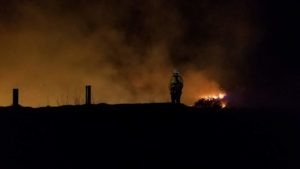
Fire crews battle the flames into the night. Photo from Imperial County and Holtville Fire Departments.
As tough as it can be on the firefighters, it can be even tougher on the families they leave behind for two weeks.
Silva said in the days before social media, families couldn’t keep up as closely as they can now. Now, they know on a moment’s notice how big a fire is or whether anyone has been injured on the line, and that can add to a family’s stress. At the same time, technology today allows families to stay in better contact with their firefighters.
In the end, it is family support that allows the firefighters to do their job. “My wife does a fantastic job taking care of the home, so it relieves any worries I might have in leaving, knowing the job she is doing,” Silva said.
Morales added, “It leaves a bit of an impact on everybody we leave behind, but the people who stay in the Valley, they look out for each other’s families. We help each other out when someone’s husband, son or grandson is away.”
He added, “So far all I have seen is families supporting what we are doing.”
Families need to be prepared to see local firefighters responding to more wildfires in the future. According to Silva, in the years ahead, Imperial Valley firefighters can expect to be called to more out-of-county wildfires as local departments have expanded their fleets to include strike three wildland engines—also known a brush trucks.

The battle against the Mendocino blaze rages on. Photo from Imperial County and Holtville Fire Departments.
These modified fire trucks are four-wheel vehicles that allow for off-road coverage. That means they can respond to locations they couldn’t in the past—climb rugged mountain terrain, like in the Mendocino blaze where the brush trucks got local firefighters onto difficult trails and roads high into the mountains.
Local firefighters also expanded their experience in wildland fires during the Mendocino blaze, learning to fight fire with fire in what is called back burning. To stop the advancing blaze, fires were set to char the land and take away fuel from the advancing blaze. It was a dangerous task, but it established a line, like a barrier, that slowed the fire.
Kaufman said there is pride in the work he and his fellow firefighters do in battling such wildfires, just as they feel every time they respond to a local call.
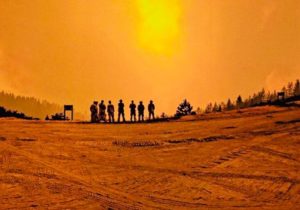
Fire crews stand together as the fire heads toward them. Photo by Holtvile and Imperial County Fire Departments.
“It’s sort of humbling,” Kaufman said. “You realize the gravity of what you do and the impact you have on lives by showing up and doing your job.”
Silva said he is proud to serve alongside his fellow Imperial Valley firefighters.
“In the Imperial Valley, every fire department has a great relationship with each other and shows great cooperation,” he said. “To me the teamwork we show is the most important thing. It doesn’t matter what patch is on your shirt or what badge you wear, we are all part of a team.”
